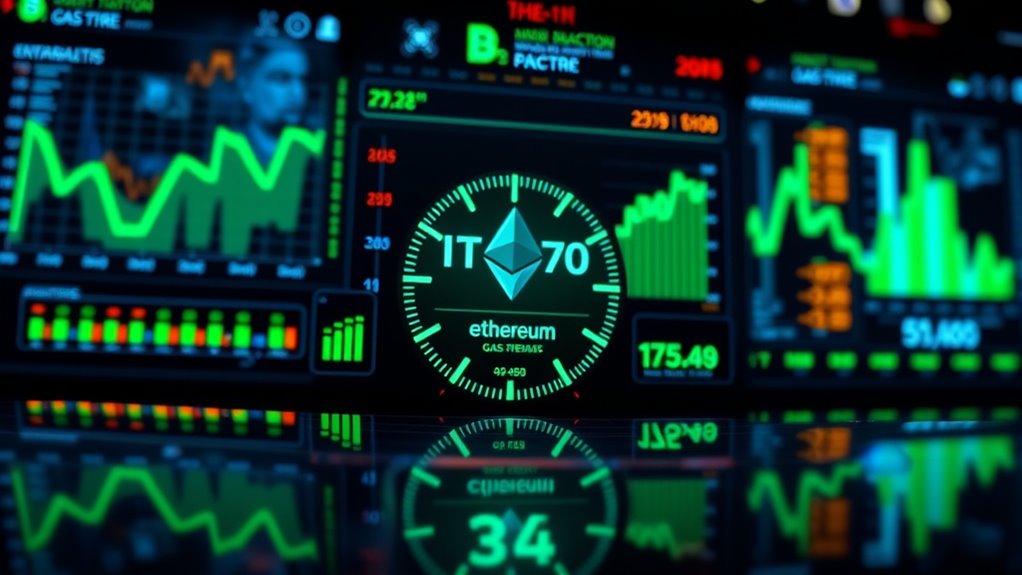After the Pectra upgrade, Ethereum’s gas fees improved but didn’t disappear. You’ll notice that during busy times like DeFi booms or market volatility, transaction costs still spike. The upgrade boosted scalability and security, but network congestion remains a challenge. To help manage costs, many users turn to Layer 2 solutions that offer faster, cheaper transactions. If you want to understand how these solutions work and what’s next, there’s more to explore below.
Key Takeaways
- The Pectra upgrade improved scalability but did not fully reduce Ethereum gas fees during peak network congestion.
- Gas fees still fluctuate significantly based on transaction demand and network activity levels.
- Layer 2 solutions remain essential for lowering transaction costs amid ongoing congestion.
- Users benefit from reduced fees and faster transactions when utilizing Layer 2 during busy periods.
- Future Ethereum upgrades aim to further optimize fees, but Layer 2 will continue playing a critical role.

Have you ever wondered why Ethereum transactions sometimes cost more than you expect? It’s frustrating, especially when you’re trying to make quick trades or move funds without breaking the bank. The truth is, gas fees are primarily driven by network congestion and how busy the blockchain gets. After the recent Pectra upgrade, many users hoped for a smoother, cheaper experience. However, while the upgrade introduced important improvements, it didn’t completely eliminate high fees. Instead, it highlighted the importance of Layer 2 scaling solutions, which are designed to reduce transaction costs and improve speed for users like you.
Layer 2 scaling refers to technologies built on top of the main Ethereum blockchain that handle transactions off-chain or in a more efficient manner. These solutions, such as rollups and state channels, bundle multiple transactions into a single batch, drastically lowering the load on the main chain. This means that your DeFi transaction costs can drop substantially because fewer transactions are competing for block space. When the network gets congested, Layer 2 options become especially valuable—they’re like express lanes that let you avoid the traffic jam. By using Layer 2, you can perform multiple transactions, swaps, or liquidity provision activities without paying sky-high gas fees each time.
The Pectra upgrade aimed to improve scalability and security, but it also underscored how dependent DeFi activities are on the underlying network. During peak periods, gas prices surge because everyone is competing to get their transactions processed first. Without Layer 2 solutions, your transactions can become prohibitively expensive, especially during DeFi booms or market volatility. That’s why more users are turning to Layer 2 options to keep costs manageable. These solutions not only cut down on fees but also increase transaction speed, making DeFi more accessible and user-friendly.
In essence, while the Pectra upgrade has made strides toward improving Ethereum’s scalability, it’s clear that Layer 2 scaling is vital if you want to minimize DeFi transaction costs. You should consider leveraging these solutions whenever possible, especially during busy periods. They help you save money and time, making your experience smoother. As Ethereum continues to evolve, Layer 2 scaling will likely become the standard way for users like you to interact with the blockchain efficiently. So, next time fees spike, remember that Layer 2 options are there to help you keep your costs low and your transactions swift.
Furthermore, advancements in project technology are expected to further optimize transaction efficiency in the future.
Frequently Asked Questions
How Will the Pectra Upgrade Influence Long-Term Gas Fee Trends?
The Pectra upgrade aims to reduce long-term gas fees by improving network efficiency. You’ll likely see lower costs as layer 2 solutions become more integrated, easing congestion on the main chain. Additionally, increased token burns help decrease supply, potentially boosting demand. This combination encourages more affordable transactions over time, making the network more sustainable and accessible for users like you.
Are There Specific Wallet Features to Reduce Gas Costs Post-Upgrade?
You’ll find that some wallets now offer features like wallet optimization and transaction batching, which can help ease your burden of gas costs after the upgrade. By smartly combining multiple transactions, you save on fees and make each interaction more efficient. It’s a gentle way to navigate higher costs, helping you stay in control while enjoying smoother, more cost-effective experiences on the network.
What Are the Risks of High Gas Fees During Network Congestion?
During network congestion, high gas fees can lead to transaction delays and increased user expenses. If you don’t time your transactions carefully, you might face long waits or have to pay more to make certain your transaction is processed quickly. It’s smart to monitor network activity, adjust gas prices accordingly, and avoid high-demand periods to minimize these risks and keep costs manageable.
How Does Pectra Compare With Other Ethereum Scaling Solutions?
Oh, Pectra’s like that friend who actually shows up early—compared to other Layer 2 solutions, it offers lower fees and faster transactions, making it ideal for decentralized exchanges. While some solutions struggle with liquidity or security, Pectra balances both, giving you a smoother experience. If you’re tired of waiting and high costs, Pectra stands out as a practical alternative, outperforming many other Ethereum scaling options.
Will Gas Fee Reductions Be Permanent or Temporary After Pectra?
Gas fee reductions from Pectra’s Layer 2 solution and transaction batching are likely to be temporary, as network activity and demand influence fees. While Pectra improves efficiency and cuts costs, these benefits depend on continued adoption and usage patterns. If demand surges, fees could rise again, so you’ll want to stay informed about network updates and scaling developments that could impact the permanence of these savings.
Conclusion
After the Pectra upgrade, you’ll notice gas fees are now more predictable and leaner than ever. While it’s a huge step forward, some still say gas costs are as high as Mount Everest, making transactions feel like climbing a mountain. But with these improvements, you’re definitely heading in the right direction. Keep an eye on the network, and soon, Ethereum’s fees might just become as smooth as silk. The future looks brighter—and cheaper!









